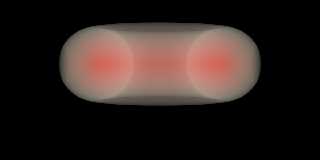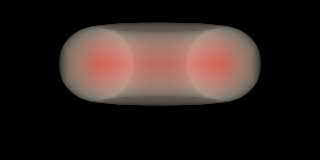 |
 |
|
 |
|
 |
|  |
|  |
|
 |
|
 |
|  |
|  |
|
 |
On 07/12/2014 09:41, Thomas de Groot wrote:
> Close, but not quite. Look at image: the torus is not complete.
>
> Thomas
>
Yep, you are right, it's wrapping the media around the torus, not what
you expected.
So, I'm calling the hgpovray branch to the rescue.
http://wiki.povray.org/content/User:Le_Forgeron#torus
The inverse of the minor radius/scale is used as parameter.
box { -1.5,1.5 hollow material { texture { pigment {rgbf 1} finish {
ambient 0 diffuse 0 } } interior { media { emission 0.3 samples 40,40
intervals
40 method 2 density { cylindrical color_map
{ [0, rgb 0]
[0, rgb <0.5,0.5,0.4>]
[1, rgb <1,0,0>] }
warp { torus <0,0,0>, 1, <7/4,1,0>
} } } } }
}
--
IQ of crossposters with FU: 100 / (number of groups)
IQ of crossposters without FU: 100 / (1 + number of groups)
IQ of multiposters: 100 / ( (number of groups) * (number of groups))
Post a reply to this message
Attachments:
Download 'tm.png' (100 KB)
Preview of image 'tm.png'

|
 |
|  |
|  |
|
 |
|
 |
|  |
|  |
|
 |
On 7-12-2014 11:25, Le_Forgeron wrote:
> On 07/12/2014 09:41, Thomas de Groot wrote:
>> Close, but not quite. Look at image: the torus is not complete.
>>
>> Thomas
>>
> Yep, you are right, it's wrapping the media around the torus, not what
> you expected.
>
> So, I'm calling the hgpovray branch to the rescue.
>
> http://wiki.povray.org/content/User:Le_Forgeron#torus
>
> The inverse of the minor radius/scale is used as parameter.
>
>
>
> box { -1.5,1.5 hollow material { texture { pigment {rgbf 1} finish {
> ambient 0 diffuse 0 } } interior { media { emission 0.3 samples 40,40
> intervals
> 40 method 2 density { cylindrical color_map
> { [0, rgb 0]
> [0, rgb <0.5,0.5,0.4>]
> [1, rgb <1,0,0>] }
> warp { torus <0,0,0>, 1, <7/4,1,0>
> } } } } }
> }
>
>
Excellent! So we have two methods now to choose from.
However, your warp code is not implemented in the latest version 3.7!
Thomas
Post a reply to this message
|
 |
|  |
|  |
|
 |
|
 |
|  |
|  |
|
 |
On 07/12/2014 13:19, Thomas de Groot wrote:
>
> Excellent! So we have two methods now to choose from.
>
> However, your warp code is not implemented in the latest version 3.7!
>
> Thomas
>
For a solution based on toroidal (original post), the solution is with
dist_exp 200 (or any big enough value) to neglect the effect of depth,
or changing the cylindrical to a pigment that has no influence due to
depth , value 1 at 0, value 0 at -1 and 1: it's planar !!!
so either :
box { -1.5,1.5 hollow material { texture { pigment {rgbf 1} finish {
ambient 0 diffuse 0 } } interior { media { emission 0.3 samples 40,40
intervals
40 method 2 density { planar
color_map
{ [0, rgb 0]
[0, rgb <0.5,0.5,0.4>]
[1, rgb <1,0,0>] }
scale 4/7
warp { toroidal orientation y major_radius 1
} } } } }
}
or
box { -1.5,1.5 hollow material { texture { pigment {rgbf 1} finish {
ambient 0 diffuse 0 } } interior { media { emission 0.3 samples 40,40
intervals
40 method 2 density { cylindrical
color_map
{ [0, rgb 0]
[0, rgb <0.5,0.5,0.4>]
[1, rgb <1,0,0>] }
rotate 90*z
scale 4/7
warp { toroidal orientation z major_radius 1 dist_exp 200
} } } } }
}
Strictly speaking, dist_exp is cheating. Planar is not.
--
IQ of crossposters with FU: 100 / (number of groups)
IQ of crossposters without FU: 100 / (1 + number of groups)
IQ of multiposters: 100 / ( (number of groups) * (number of groups))
Post a reply to this message
Attachments:
Download 'pla.png' (100 KB)
Download 'tm.png' (100 KB)
Preview of image 'pla.png'

Preview of image 'tm.png'

|
 |
|  |
|  |
|
 |
|
 |
|  |
|  |
|
 |
Le 14-12-07 04:24, Thomas de Groot a écrit :
> The best way to achieve my initial question in p.advanced-users is the
> solution given by Alain: using a torus function for the density:
>
> #local Radius = 30;
> #local F_pig = pigment {function {f_torus(x,y,z, 1.0, 0.15)}};
>
> torus {1.0, 0.15
> hollow
> material {
> texture {
> pigment {rgbt 1}
> }
> interior {
> media {
> intervals 1
> samples 10
> emission 0.5/Radius
> density {
> pigment_pattern {F_pig}
> color_map {
> [0.8 rgb <0,1,0>]
> [1.0 rgb <1,0,0>]
> }
> }
> }
> }
> }
> scale Radius
> rotate 10*x
> rotate 15*z
> }
>
>
> Now, I need to investigate further in combining this with toroidal warps
> and other media matter. My ultimate goal is to achieve a credible Milky
> Way that can be seen from a planet for instance.
>
> Thomas
The milky way is not toroidal but a barred spiral that is thicker in the
center and tapper off toward the edges in a lenticular way.
A combination of spherical, with uneven scalling for the central bulge,
and turbulated planar could be the best way to do it.
Alain
Post a reply to this message
|
 |
|  |
|  |
|
 |
|
 |
|  |
|  |
|
 |
On 07.12.2014 20:09, Alain wrote:
> A combination of spherical, with uneven scalling for the central bulge,
> and turbulated planar could be the best way to do it.
The spiral1 pattern may also be useful for this purpose.
Post a reply to this message
|
 |
|  |
|  |
|
 |
|
 |
|  |
|  |
|
 |
On 7-12-2014 23:11, Christian Froeschlin wrote:
> On 07.12.2014 20:09, Alain wrote:
>
>> A combination of spherical, with uneven scalling for the central bulge,
>> and turbulated planar could be the best way to do it.
>
> The spiral1 pattern may also be useful for this purpose.
Well, as you realize, seen from a planet's surface, the basic shape is
not really important. I could also just use a cylinder or a box within
the camera view ;-)
However, I want to go a little bit further than just that make-believe
and so came up with a torus. Btw, Nekar's spiral galaxy in the Objects
Collection might also be a possibility to investigate.
Thomas
Post a reply to this message
|
 |
|  |
|  |
|
 |
|
 |
|  |
|  |
|
 |
On 7-12-2014 18:28, Le_Forgeron wrote:
> For a solution based on toroidal (original post), the solution is with
> dist_exp 200 (or any big enough value) to neglect the effect of depth,
> or changing the cylindrical to a pigment that has no influence due to
> depth , value 1 at 0, value 0 at -1 and 1: it's planar !!!
>
[snip]
>
> Strictly speaking, dist_exp is cheating. Planar is not.
>
Interesting. I wondered how to use dist_exp as the docs are not very
clear on that issue and I did not know what it really represented.
Thanks indeed
Thomas
Post a reply to this message
|
 |
|  |
|  |
|
 |
|
 |
|  |
|  |
|
 |
Le 08/12/2014 09:20, Thomas de Groot a écrit :
> On 7-12-2014 18:28, Le_Forgeron wrote:
>> For a solution based on toroidal (original post), the solution is with
>> dist_exp 200 (or any big enough value) to neglect the effect of depth,
>> or changing the cylindrical to a pigment that has no influence due to
>> depth , value 1 at 0, value 0 at -1 and 1: it's planar !!!
>>
> [snip]
>>
>> Strictly speaking, dist_exp is cheating. Planar is not.
>>
>
> Interesting. I wondered how to use dist_exp as the docs are not very
> clear on that issue and I did not know what it really represented.
>
Not clear ? Not extensive, maybe confusing, but seems clear:
to cite the wiki:
With the cylindrical, spherical and toroidal warps you can wrap
checkers, bricks and other patterns around cylinders, spheres, toruses
and other objects. In essence, these warps use the same mapping as the
image maps use.
However it does 3D mapping and some concession had to be made on depth.
This is controllable by dist_exp (distance exponent). In the default of
0, imagine a box <0,0> to <1,1> (actually it is <0,0>,
<dist^dist_exp,dist^dist_exp>) stretching to infinity along the
orientation vector. The warp takes its points from that box.
> Thanks indeed
>
> Thomas
--
Just because nobody complains does not mean all parachutes are perfect.
Post a reply to this message
|
 |
|  |
|  |
|
 |
|
 |
|  |
|  |
|
 |
On 8-12-2014 9:53, Le_Forgeron wrote:
> Not clear ? Not extensive, maybe confusing, but seems clear:
> to cite the wiki:
>
> With the cylindrical, spherical and toroidal warps you can wrap
> checkers, bricks and other patterns around cylinders, spheres, toruses
> and other objects. In essence, these warps use the same mapping as the
> image maps use.
>
> However it does 3D mapping and some concession had to be made on depth.
> This is controllable by dist_exp (distance exponent). In the default of
> 0, imagine a box <0,0> to <1,1> (actually it is <0,0>,
> <dist^dist_exp,dist^dist_exp>) stretching to infinity along the
> orientation vector. The warp takes its points from that box.
>
Indeed. I understood the meaning :-) but I assumed that the distance was
to be used /within/ the boundary of the minor radius, so in my trials it
was always rather small.
Thomas
Post a reply to this message
|
 |
|  |
|  |
|
 |
|
 |
|  |
|  |
|
 |
On 08.12.2014 9:16, Thomas de Groot wrote:
> Well, as you realize, seen from a planet's surface, the basic shape is
> not really important. I could also just use a cylinder or a box within
> the camera view ;-)
Oh I see, you want to render an inside view ;)
In that case the shape is indeed not so important ... absorption is
so high (at visible wavelengths) that most light you see from the Milky
Way is from our "local" galactic neighborhood only (~ 1 kpc radius).
Post a reply to this message
|
 |
|  |
|  |
|
 |
|
 |
|  |
|
 |




![]()